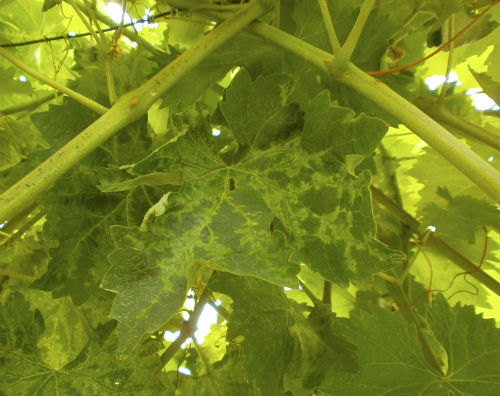Grapevine pinot gris virus
Grapevine pinot gris virus (GPGV) was detected in Australia in late 2016. It was first identified overseas in 2012, although it may have been present for about 10 years.
GPGV has been found on more than 30 grape varieties worldwide and was first detected on pinot gris.
GPGV symptoms
Symptoms of GPGV appear soon after bud break. Symptoms consist of:
- shortened internodes
- leaf mottling
- yellow spots
- leaf deformation
- delayed bud burst
- mite attack
- poor fruit set





GPGV, however, can be symptomless making it impossible to identify by visual symptoms.
GPGV disease cycle
GPGV is spread by grapevine bud and blister mites and propagating material. It has been detected in the weeds fat hen (Chenopodium album) and white campion (Silene latifolia), suggesting they can harbour the virus.
Controlling GPGV
It is important to maintain good on-farm biosecurity to prevent spread of GPGV.
You can do this by controlling weeds and insect pests, inspecting vines, using virus tested propagation material and reminding visitors of good on-farm hygiene.
Submit for testing
You can contact the Crop Health Services team on (03) 9032 7323 for a quote on testing. They will also advise how to collect, package and send the samples for analysis.
Photo credits
Figure 1. Photo courtesy of Carlo Flamini, Elisa Angelini, Irene Bazzo, Nadia Bertazzon, Luisa Filippin and Vally Forte Il Corriere Vinicolo, press media of Unione Italiana Vini, Italy
Figure 2. Photo courtesy of Dr. Pasquale Saldarelli, Institute for Sustainable Plant Protection of the National Research Council
Figure 3. Photo courtesy of Dr. Pasquale Saldarelli, Institute for Sustainable Plant Protection (IPSP) of the National Research Council
Figure 4. Photo courtesy of Dr Giulio Franco [ERSA]
Figure 5. Photo courtesy of Carlo Flamini, Elisa Angelini, Irene Bazzo, Nadia Bertazzon, Luisa Filippin and Vally Forte Il Corriere Vinicolo, press media of Unione Italiana Vini, Italy